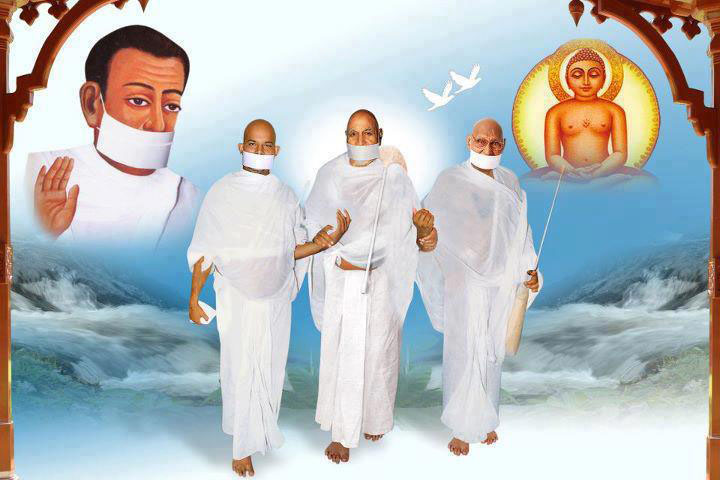Terapanth
 |
Terapanth is a religious sect under Swetembar Jain. The terapanthi sub-sect is derived from the Sthanakvasi section. The Terapanthi sub-sect was founded by Swami Bhikkanaji Maharaj. SwamiBhikkanaji was formerly a Sthanakvasi saint and had initiation from his Guru, by name Acharya Raghunatha. Swami Bhikkanaji had differences with his Guru on several aspects of religious practices of Sthanakvasi ascetics It was Founded by Acharya Bhikshu in Vikram Sambat 1817 i.e. June 28th of 1760 (Saturday) at Kelwa (a small town in Udaipur District of Rajasthan State). This sect is entirely based upon the Ideology of Jain.
 |
As Acharya Bhikkanaji laid stress on the 13 religious principles, namely (i) five Mahavratas (great vows) (ii) five samitis (regulations) and (iii) three Guptis (controls or restraints), his sub-sect was known as the Tera (meaning thirteen)-pantha sub-sect. In this connection it is interesting to note that two other interpretations have been given for the use of the term Terapantha for the sub-sect. According to one account, it is mentioned that as there were only 13 monks and 13 laymen in the pantha when it was founded, it was called as Tera (meaning thirteen) -pantha. Sometimes another interpretation of the term Terapantha is given by its followers. Tera means yours and pantha means path; in other words, it means, "Oh! Lord Mahavira! it is Your path ( Panth )".
Hai Prabhoo Yeh Terapanth : This practice of regulating the entire Pantha by one Acharya only has become a characteristic feature of the Terapantha and an example for emulation by other Panthas. It is noteworthy that all monks and nuns of the Terapantha scrupulously follow the orders of their Acharya, preach under his guidance and carry out all religious activities in accordance with his instructions. Further, the Terapantha regularly observes a remarkable festival known as Maryada Mahotasava. This distinctive festival is celebrated every year on the 7th day of the bright half of the month of Magha when all ascetics and lay disciples, Sädhus (monks) and Sädhvis (nuns) are people who have voluntarily given up their household lives and worldly affairs and have accepted the five major vows to uplift their souls on the spiritual path. They strictly follow the rules laid down for them. Shrävaks and shrävikas, on the other hand, continue to lead worldly lives. They may observe in full or to a limited extent, twelve minor vows laid down for them.
Terapanth is non-idolatrous and are very finely organized under the complete direction of one Acharya, that is, religious Supreme. In its history of little more than 200 years, the Terapantha had a succession of only 10 Acharyas from the founder Acharya Bhikkanaji as the First Acharya to the present At present Acharya Mahaprajna is the supreme head. He is the Tenth Acharya of Terapanth religious sect comprising more than 850 monks , nuns, samans and samanis( a new rank between the ascetic and the lay - followers ) following critical codes of disciplines, and millions of followers all over the world.
Apart From founder Acharya Bikshu Swami & other Acharya's , Acharya Jeetmal popular name "Jayacharya" ( the 4th Acharya ) & Gandipathi Acharya Shree Tulsi (the ninth Acharya) was a missionary in the history of Terapanth. The were a adorable torch - bearers of great spiritualistic tradition of India. People designated him a "lord of Humanity" His strenuous efforts are well known to the common people.
All Acharayas of Terapanth (All Dates according to the respective Acharyaships)
Acharya Bhikshu (1760-1803)
Acharya Vharimal (1803-1821)
Acharya Raichand (1821-1851)
Acharya Jeetmal (1851-1881)
Acharya Maghraj (1881-1892)
Acharya Manaklal (1892-1897)
Acharya Dalchand (1897-1909)
Acharya Kalugani (1909-1936)
Acharya Tulsi (1936-1996)
Acharya Mahaprajna (1996-Till date)
Presently Yauvacharya is : Mahasaman Muni Muditkumarjee
Presentley Sadhi Parmukha is : Mahasamani Sadhvi Kanak Prabhajee
At the time terapanth foundation there was only 13 monks and no nuns. In V. S. 1821 three women approach to Acharya Bikshu for Diksha and qualified. Since there was no nuns before and as per rules minimum three nuns required to stay. In case one nuns change her mind how to face such situation. Hence Acharya bikshu asked all three women in case such think take place then remain two need to go for fasting till death known as Santhara - Salekhana. All three women taken diksha V. S. 1821 and these are namely Sadhivi Kusalanjee, Sadhivi Matatujee, Sadhivi Ajabujee. Credit go to Sadhiv's for 1st Women diksha after the 13 terapanth founder monks. Monks further added in V. S. 1822.
Sadhivi Kusalanjee was leader of remain two nuns as like Monk Thirpaljee was leader for 11 monks and all are under umbrella of Acharya Bikshu. From V. S. 1821 to Till Administration of Acharya Tulsee total 1597 women become true terapanthi nuns.
Table of becoming nuns in each Acharya's are as under.
Acharya Bhikshu (1760-1803) - 56 Nuns
Acharya Vharimal (1803-1821) -44 Nuns
Acharya Raichand (1821-1851) - 168 Nuns
Acharya Jeetmal (1851-1881) -224 Nuns
Acharya Maghraj (1881-1892) - 83 Nuns
Acharya Manaklal (1892-1897)-25 Nuns
Acharya Dalchand (1897-1909) -125 Nuns
Acharya Kalugani (1909-1936)-255 Nuns
Acharya Tulsi (1936-1996) - 617 Nuns
Till the third Acharya Raichandjee there was no Custom for appointing a leader for the nuns. This responsibility were carried out by Acharya's preferred nuns. Sadhvi Barjujee were looking this job during Acharya Bikshu administration, Sadhvi Hiranjee were during Acharya Bharimaljee , Sadhvi Dipanjee during Acharya Raichandjee.
4th Acharya Shree Jeetmaljee has set-up a custom for Leadership for nuns called as "Sadhvi Parmukha". As nuns were increasing hence it was required to maintain deiscpline. The 1st Sadhvi Parmukha Sardarajee appointed by Acharya Shree Jeetmaljee in V. S. 1910. Then after total seven Sadhvi Parmukha including present Parmukha Sadhvi Kanak Prbhajee. The table are as under.
Sadhvi Parmukha Sardrajee V.S. 1910-1927
Sadhvi Parmukha Gulabajee V.S. 1927-1942
Sadhvi Parmukha Navlajee V.S. 1942 - 1954
Sadhvi Parmukha Jethanjee V.S. 1954 - 1981
Sadhvi Parmukha Kankuvarjee V.S. 1981 - 1993
Sadhvi Parmukha Jamkujee V.S. 1993 - 2003
Sadhvi Parmukha Landajee V.S. 2003 - 2027
Sadhvi Parmukha Kanakprbhajee V.S. 2028- till date
Guru Dev Tulsi who is now no more was magnanimous in life and glorious in death. He lives for ever in the hearts and minds of millions of people for whose mental, emotional, and spiritual upliftment he worked all through his life. He was borned in 1914 at Ladnun (a small town in Nagaur District of Rajasthan). Right from his early childhood he exhibited brilliant qualities of head and heart giving indications of his greatness to be and his spiritual inclinations. He renounced the material world and became a recluse at the tender age of 11years and showed promise to this difficult path with remarkable dedication. He thus rose in the saintly order to the highest seat in Terapanthi order of saints. The young saint Tulsi surpassed all estimates being made about him by the keen observers of the society. This young talent through his dynamism and sense of purpose , captured the attention of his Guru Shri Kalugani who nominated him to be his successor and he actually succeeded to his seat at the young age of 22 years. He thus had the credit to be the youngest of the eight Acharya’s who preceded him.
Acharya Shri Tulsi was a great visionary and conceived many innovative programmes and schemes to uplift the mental, moral and emotional status of his disciples and the entire population at large. He had the unique quality to translate his vision into actual practice. Rastrapita Mahatma Gandhi is the only other name which captures our imagination in this context. Acharya Tulsi showed great dynamism in conceiving and forth-rightly implementing the Anuvrat Movement for moral regeneration of the nation. The five principles of Anuvrat (brief resolves for leading an upright life) i.e. Satya, Ahimsa, Aparigraha, Achaurya and Brahmacharya became the five pillars of this movement for adoption in real life by individuals. This movement made a good headway through the teaching of his disciple saints , the foremost among them being Acharya Mahaprajna , the present head of the Terapanth sect This awakened the nation to a new moral code and cleansed the personal life of a large multitudes of the people giving them a sense of confidence and a direction for a purposeful upright living.
Gurudev Tulsi took up another gigantic task of editing the age old Jain ‘Agamas’-(shastras) which constitute the canonical literature of the Jain’s. In this trend he and his chosen disciples undertook research in depth on this ‘Shastras’ and discovered the ancient Jaina Technique of Meditation which he named as ‘Preksha dhyana’ This system of Jain Meditation was so well developed under his and Acharya Mahaprajna’s spiritual guidance that it completely revolutionised the Meditation techniques so far practised by the Jain Saints.
Besides controlling and administering a saintly order of nearly 800 monks, nuns, samans andsamanis. Acharya Tulsi was seriously absorbed in thinking about the future of the nation. His main concern in this regard was the education of our children and young men -the real citizen of tomorrow. After a deep probe into the contents and methodology of present day educational system Gurudev and Acharya Shri Mahaprajna discovered some serious loopholes which needed to be plugged to make it really effective and useful.
Acharya Shri.noticed that in the current system though it was advancing in technical and intellectual field but it cared little for emotional development of the students. This lacuna leads to many evils in the society & proves an impediment in the balanced and harmonious development of a youth’s personality. Gurudev Tulsi along with Acharya Mahaprajna worked out a wonderful innovation of ‘Jeevan Vigyan’ (Science of Living) as his latest contribution to our educational system to engineer a balanced growth of mental and emotional faculties among the Youth.
A remarkable and historical event of Gurudev’s immaculate life history is his willing and voluntary abdication of his ‘Acharya Pad’ (headship of Terapanthi saintly order) in favour of Acharya Shri Mahaprajna Ji. His is a landmark in Indian Saintly tradition unprecedented & unheard so far. This speaks Volumes of his ‘Tyag Vriti’ (non-attachment to mundane glory). The world will remember him for many years to come.
-----------------------------------------------------
Mail to : Ahimsa Foundation
www.jainsamaj.org
R9111